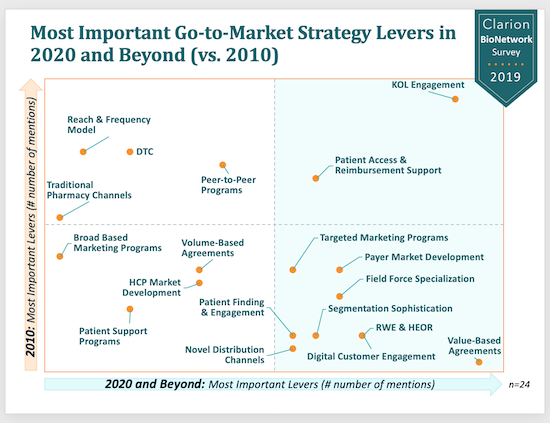Launch Strategies: What You Need to Know in 2020
In 2020 and beyond, succeeding in the new ecosystem means focusing on delivering value backed by data, tailored engagements with a diverse range of distinctly defined stakeholders, and monitoring the rapidly evolving healthcare space for new trends that will impact success.
Bart Lombardi

Therapeutic innovation, use of predictive analytics and AI, increasing role of patients and caregivers, market access restrictions, pricing pressure, new manufacturing and distribution channels and players, to name just a few – the ecosystem surrounding biopharmaceuticals is changing in transformative ways along numerous dimensions. The challenge is to recognize how these factors affect new product introduction in 2020 and beyond and proactively adapt commercialization strategies. In the years to come, those biopharma leaders who integrate deep customer insights, leverage new technologies to identify and engage customers, focus on delivering value, and continue to anticipate the impact of evolving market and healthcare dynamics will have the most successful new product launches.
This article offers insights from two complementary sources: a panel moderated at CBI’s 5th Annual Bio/Pharmaceutical Product Commercialization and Launch Roadmap Conference and Clarion’s second annual BioNetwork Survey of senior US biopharmaceutical executives, conducted in October 2019.
Three key industry trends shaping tomorrow’s go-to-market strategies
What do US biopharma executives think will be the most impactful trends affecting successful new product commercialization in 2020 and beyond?

1) Increasing market access restrictions, including US payer adoption of new-to-market blocks, growing exclusion lists, higher patient out of pocket costs, challenging reimbursement setup, among others. Market access challenges can change launch dynamics in fundamental ways. For example, new-to-market blocks diminish the traditional opportunity for healthcare providers (HCPs) to trial a new pharmacy benefit product and begin to establish early physician demand, hindering uptake in the critical first 6 months of launch. More broadly, the bar has been raised to provide compelling evidence of product differentiation and value to secure coverage. As one of our panelists suggested, “good products can still get strong market access, it just takes a lot of dedicated effort, years in advance, with significant collaboration across clinical, medical, and commercial teams.”
2) Downward pressure on pricing by policymakers (and politicians), health plans, and benefit managers. The uncertainty and potentially sweeping impact of policy changes is challenging to biopharma companies – as one executive survey respondent pointed out, “uncertainty on which legislative or regulatory actions will be taken creates many different scenarios to consider and monitor, particularly for forecasting.” The focus of media attention on this issue is often around limiting price increases over time. Such restrictions would put pressure on biopharma companies to get the price right at launch. That in turn means getting ahead of potential pricing criticisms with robust rationale and supporting evidence. One-time, curative therapies (e.g., gene and cell therapies) are navigating this situation today.
3) Entry of novel distribution channels was the trend most often cited as transformative by executives in our survey. On one end of the spectrum, there are advanced therapies like gene and cell therapies driving the need for new logistical solutions (e.g., chain of identity, chain of custody) in a nascent supply chain that is completely outside traditional drug distribution channels. On the other, there are new players leveraging digital technology and the consumerization of healthcare to potentially revolutionize the way most drugs are sold. For instance, Amazon, one such potential player, would not be just another wholesale channel to sell into, but represents a radically different consumer-centric, e-commerce platform that is dominating the broader consumer marketplace. In competitive markets, Amazon could enable unprecedented consumer engagement in prescription medication feature and price comparisons and provide a seamless acquisition process integrated into a platform that consumers shop through every day.
Adapting commercialization strategies to new market realities
What strategic levers are most important to succeeding in this evolving landscape? Forward-thinking and innovative companies in the industry already have and continue to evolve their approach. Many aspects of “traditional” launch playbooks (e.g. sales force scale, A&P spending, broad marketing campaigns, share-of-voice measure) are being replaced by greater focus on sales force sophistication, real-world evidence (RWE), high quality, direct patient engagement, and innovative payer contracts and access programs.

Among the specific levers our panelists and survey respondents viewed as being most important are:
• Demonstrating product value. Biopharmas need to get ahead of access barriers by generating and communicating evidence of the differentiated clinical and economic value of their new therapies. Value evidence generation needs to start early, with medical and commercial input into clinical study design, even earlier than pivotal studies. Engaging with payers and other stakeholders also needs to start early (i.e. years, not months before launch) to educate on the disease and unmet needs as well as understand what value means to each stakeholder. As one of our panelists suggested, “phase 1 is not too early to be working on market access.” Moreover, it doesn’t stop at launch – increasingly there is need to continue demonstrating value through real-world data.
• Meaningful engagement with the expanded set of influencers and decision makers. Our survey respondents and panelists acknowledged that key opinion leader (KOL) engagement (traditionally focused on HCP KOLs) has always been and continues to be a key factor in successful product introduction. However, the reasons to engage KOLs-to gather insights, educate, and secure advocacy-are increasingly critical across a broader set of stakeholders, including payers, regulators, and notably, patients, caregivers, and advocacy groups. Patients are empowered by increased access to information and are actively taking a greater role in healthcare decisions. To be successful, biopharma companies need to meaningfully engage patients/caregivers and advocacy groups to understand their needs at a fundamental level and communicate information in highly tailored ways. Across stakeholder groups, the nature of information being communicated is also increasingly complex, owing to more nuanced science and new data sources. To this end, Medical Affairs is emerging as a critical strategic leader of scientific and data-focused engagement across stakeholders, leveraging their scientific and clinical expertise. Biopharma companies are wise to invest in forward-looking Medical Affairs capabilities that enable optimal experiences and outcomes for all stakeholders.
• Sophistication in customer segmentation. Healthcare stakeholders no longer accept a “one size fits all” approach, but luckily, we have also seen the advent of the data and engagement channels required to more robustly characterize customer archetypes and their unique needs, as well as tailor content and engagement accordingly. Artificial intelligence (AI)-based approaches are being applied throughout the entire value chain from drug discovery to patient finding to commercial marketing. This sophistication relies on advanced analytical and computational capabilities, areas where biopharma has formerly lagged other industries and is catching up. Biopharmas should identify the data capabilities that are most critical to success, given their specific product portfolio and company strategy, and invest to build or acquire the right enabling talent and infrastructure.
• Multi-faceted customer-facing field teams. The ongoing shifts in stakeholder dynamics and the types of new drugs entering the market require companies to think more critically about the structure and makeup of their field force to ensure customer needs are met. Increasingly this means engaging customers through a team of personnel with specialized capabilities. Healthcare providers and their staff are more and more being engaged not only by sales representatives and medical science liaisons (MSL), but also commercial thought leader liaisons, field reimbursement specialists, and clinical educators. For payers, many companies now employ medical outcomes specialists as well as traditional commercial account managers, and patients and their caregivers may interact with patient educators, case managers, reimbursement support specialists, and patient advocacy engagement personnel. These field teams need to be highly coordinated to maximize the impact of their collective efforts.
Although our industry is changing in fundamental ways, biopharma leaders can get ahead of the curve to succeed in the new ecosystem. In 2020 and beyond, this means focusing on delivering value backed by data, tailored and meaningful engagements with a diverse range of more distinctly defined stakeholders, and continuing to monitor the rapidly evolving healthcare space for new trends that will impact success moving forward.
Bart Lombardi is a founder and managing director of Clarion, a Life Sciences Consultancy.
The Misinformation Maze: Navigating Public Health in the Digital Age
March 11th 2025Jennifer Butler, chief commercial officer of Pleio, discusses misinformation's threat to public health, where patients are turning for trustworthy health information, the industry's pivot to peer-to-patient strategies to educate patients, and more.
Navigating Distrust: Pharma in the Age of Social Media
February 18th 2025Ian Baer, Founder and CEO of Sooth, discusses how the growing distrust in social media will impact industry marketing strategies and the relationships between pharmaceutical companies and the patients they aim to serve. He also explains dark social, how to combat misinformation, closing the trust gap, and more.
Applying Porter’s Five Forces to Portfolio Management in Pharmaceutical R&D: A Strategic Roadmap
March 17th 2025The increasing costs and complexity of R&D in the pharmaceutical industry have necessitated the adoption of strategic portfolio management to optimize resource allocation and enhance competitive advantage.